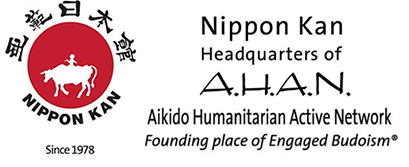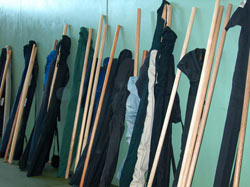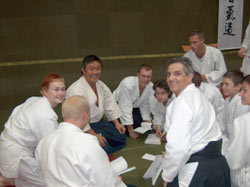Inspired by Students in Ostrava, Czech Republic 10-29-03
By
Gaku Homma
Nippon Kan Kancho
I am fairly sure that even twenty years ago, keiko-gis (practice uniforms) were not white. They were not bleached, and when brand new was the cream color of hemp. Today, finding uniforms of this color is rare.
It used to be, that the only people in the dojo who had white keiko gis were Sensei or sempai (senior students), and their uniforms were an admired as a symbol of experience. The keiko gi of Sensei and sempai did not start out white. They turned white through daily practice and daily washings, scrubbed clean by hand with bar soap and cold water. When I practiced as an uchideshi in Japan, there was no hot water, much less fabric softener, bleach or dryers.
About the time that a keiko gi would turn the coveted color of white, it also began to tear and fray. Especially the collar would tatter, and the lower back and shoulder areas would grow threadbare from endless hours of ukemi. The uniform pants would of course split, showing gaping smiles at the knees. Keiko gi pants were hidden by one’s hakama,which of course was also torn and worn bare at the knees. All of these tatters were kind of a “badge of honor”, worn with a sense of pride.
Finally the day would come when one more iriminage throw would result in a resounding ripping noise…and it was time to say goodbye. Like saying goodbye to an old friend, this was a reluctant goodbye however, and much time and ingenuity was spent mending and patching both keiko gi and hakama to postpone the parting. Over and over hakama and keiko gi were mended until there was not enough material left to patch.
In years past, Morihiro Saito Shihan used to sing a song when he was happy called Shiroi Keiko Giin Japanese. This title translates literally as “white keiko gi”. The white keiko gi in the song refers not only to ones practice uniform, it also metaphorically is a symbol of our practice spirit. The whitekeiko gi in the song symbolizes a purity of mind and spirit and a renouncement of attachments and other distractions that keep one from their practice. A white keiko gi for many martial artists has historically been a symbol of pride, commitment and accomplishment.
Today it seems that many Aikidoka have lost the sense of joy and pride one can find in a wornkeiko gi, and the sweet sadness of saying goodbye to a keiko gi too worn to wear. This feeling has disappeared among Aikidoka and white keiko gis can be bought off the shelf. Keiko gis today come in designer styles and almost always come white right out of the bag.
Having just returned from the Czech Republic, I want to relate to you a wonderful experience I had while I was there. Last year when I was teaching in the Czech Republic, I did not focus too much on weapons practice so I did not notice something special until this year. What I found, I have actually had also seen in Mexico and Brazil. Before practice began, students arrived and as is customary, leaned their weapons bags upright across the back wall. At first, this did not strike me as unusual, until I looked more closely. In a state of excitement I grabbed my camera to capture what had caught my eye.
All of the weapons cases were made by hand. They were made of different materials, in different sizes and with different straps and handles. It reminded me of when I practiced in Japan as a youth and most students then made their own weapons cases too. At that time, you could find “ready-made” cases for a jo or a bokken, but not for both, therefore we made our own. Anyone with moderate sewing skills could make a weapons case from old cloth in about a half an hour.
For us at that time in Japan, making our own weapons case was quite valuable. Today in the United States, $60-$80 commercially produced weapons cases are common, but they lack the individuality, heart and care it takes to make your own.
I think it an important part of our practice to nurture this sense of pride and respect for the tools we use in our art. Japanese instructors should be familiar with this practice from their own training and especially instructors teaching in countries other than Japan should be teaching this sense and manner as well.
Part of Japanese heritage, the soil that bore the spirit of Aikido and other Japanese based arts is founded in this kind of thinking. I returned to Japan not long ago, and I stopped at Hombu dojo in Tokyo to watch Doshu’s morning practice to pay my respects. As I watched, Shigeru Okumura Shihan (Aikido Aikido 9th dan) who is well into his eighties, entered the dojo. He was quite friendly but his presence filled the room as he formally greeted every person he met. He moved toward the area where I sat observing class and greeted me, a visitor, with such an air of dignity and humility it made a deep impression. One thing that also left an impression on me was the keiko gihe was wearing. It was quite old, and of course it was white in color. The collar was tattered and so worn that another strip of cloth had been neatly sewn over the collar to hold it together. The knee area of his hakama had also been neatly and carefully stitched, patched to reinforce it.
Someone of Okumura Shihan’s status could bring a uniform merchant running to his aid with a clearing of his throat, yet his keiko gi was so old it had taken on the shape of his body. It was so well mended and cared for it had taken on the shape of his heart. There is not a new uniform made that could match his uniforms comfort or the message it carried. It was a lesson he presented to everyone he met and I found it to be an inspiration.
The United States is a wealthy country, and students who come to Nippon Kan after school or work have the means to pay dues and purchase keiko gis for practice. There is a market in the United States for high priced, designer wares, but the times recently have not been as secure as they have been in the past. In the past few years, layoffs have become commonplace, as have cuts in pay. I have heard many bad luck tales from my own students as well as from the homeless that I have met at the Denver Rescue Mission. Nippon Kan has been serving meals to the homeless for thirteen years now, and it is startling to see that recently there have been more highly educated and professional people in their midst.
Talking with some of these “newly homeless” I heard many of the same stories. They all related in varying degrees that it was not long ago that they had “the world by the tail” so to speak. They could easily find a job, and changed or upgraded their jobs frequently. “It was easy to achieve any dream I wanted, I did not have to look down, I just always looked ahead. Then one day I woke up, and the bottom had fallen out. I woke up in a place I never thought I would be. Now I can’t see right or left, or find which a way out”. This is become the new bottom for many of the new up and coming, of whom I have seen more of looking instead for a hot meal at the mission.
There is a saying in Japan about someone who has found themselves in this sort of plight. It is said, “They are weak in the legs”, meaning that they are strong on top, ie., they have a good head, but their personal foundation is not stable. They are not flexible like bamboo in winter and soon break. These seem to be the times we are in, and all more reason to respect and take care of the things we need for our practice.
From a worn keiko gi we can learn many things. From handmade weapons cases and other accessories we can learn many things as well. As I have written in other articles, sometimes Aikidoka look like kindergarten school children dressed in professional football gear; they have the latest in designer gear, but know very little about their practice. While this is written somewhat in jest, there are also Aikidoka and other athletes in the world who practice without any uniform at all, or grow up playing soccer or other sports barefoot in the streets. Many famous players have come from this stock, and their spirit should be well noted.
I had the chance last summer to show an American-made weapons case that sells for about $80.00 to a friend of mine who is a native craftsman in Mongolia. He was surprised at the price, and told me if I ordered a hundred from him, that he could make them easily for about $7.00. He sent me a sample based on what I told him, and I was surprised with the quality of his prototype. It would not be unreasonable to find such a case on the market for over $100.00. I have found the same to be true for bokken that sell in the United States for about $100.00. In a dojo in Brazil, students made bokken from the same oak as Iwama style bokken oak in Japan, and they sell them for about $20.00. The point is that the material value in these Aikido accessories is little. What is important and most valuable is the soul that went in to its making, and the place it takes in our hearts. For people from any country, especially artists, craftsmen, musicians and sportsmen, this shared value is priceless. This is the spirit we need to recognize. Being aware of this value and exercising care for the tools of our art is an important part of understanding what it is we practice. This was part of the Founder Morihei Ueshiba’s spirit and heart. It is not a lesson of the Founder that you can learn by reading a book. It is a lesson that is learned through daily practice, each day, as part of our daily life.
This coming Christmas season, if a new keiko gi was on your list, take another look at the one you have now. The history of your practice is written there. The money that you might spend to buy a new designer keiko gi, or the money that you might save by buying a more modest keiko gi, could feed as many as 150 children for one day in many countries, or be used for local community projects in your area. Weapons cases made by hand from old cloth make wonderful gifts that come from the heart. Even if your sewing is not award winning, and the case you make is not perfect, the value of the happiness it would bring is immeasurable.
All of these thoughts came flooding to my mind as I stood and looked at the weapons cases lined up neatly in a row at the seminar in Ostrava. The Czech Republic, I was learning, had emerged from communist rule only fourteen years ago, and today sported generations of Aikidoka that I am proud to have been able to meet. The people of the Czech Republic possess a heritage and a culture that shows its resilience. Especially the young people training here that day practiced well, with heart and skill. At the end of the day they returned their weapons to the hand sewn cases they had so carefully made, and folded theirkeiko gi’s into simple gym bags. There was an innocence and vitality that made me feel very good inside.
In the United States, I have seen seminars where hundreds of the same weapons cases lined the walls before practice. I am sure that would make the producers of these cases happy, but it makes me sad to think of the lesson and experience and learning that is missing in something as simple as a home made case for a bokken and jo. A great deal has been torn away, and to me it feels somewhat like an infection has over come a valuable tradition, and become its own.
On the flight back, I jot down these thoughts as I peer out the window at the fast approaching coastline of the United States as we grow near. For me this has been a very good trip that has reminded me of many things. I look forward to returning there soon.
Gaku Homma
Nippon Kan Kancho
Oct 29, 2003



